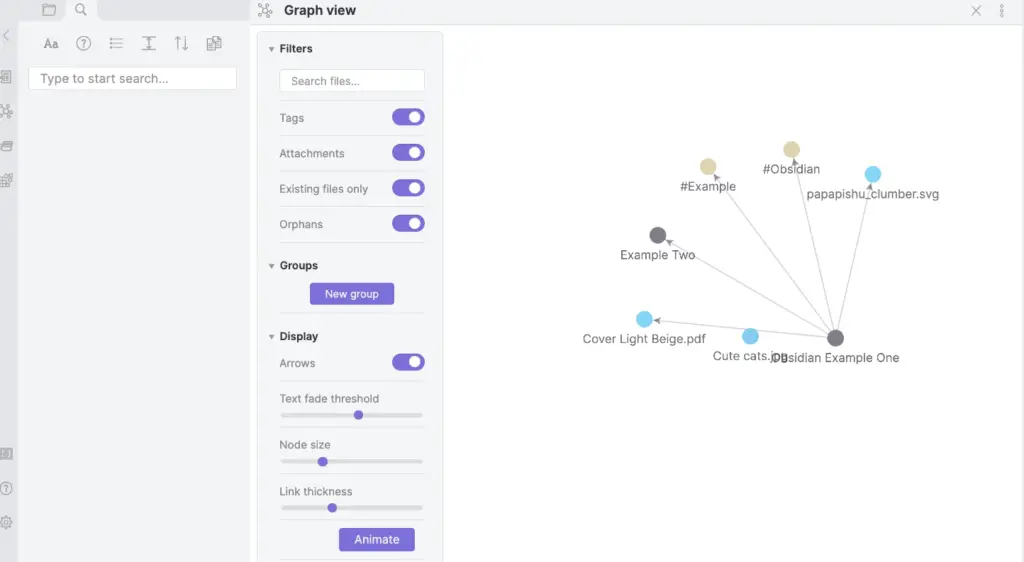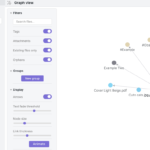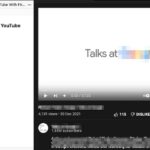I am exploring how to improve notes with associative thinking; It can be one of the more important note-taking traits to develop that involves understanding, memory, and creativity.
How to link up your notes with associative thinking?
- Meaning
- Visual graphics
- Alphabets
- Numbers
- Colors
- Musical patterns
- Codes
- List of words
- Sounds or pronunciations
- Activities
- Obsidian note app
The idea of associative concepts reminds me of a particular programming concept in C programming known as a linked list with pointers; Basically, a list of elements that contain the memory address to another list and so on. For human understanding, I believe the association has to be more meaningful and intuitive to be potent.
Meaning
This is the most logical and natural way of academic and usual frequent linking for associative thinking in my opinion.
For example, trees -> wood types -> furniture building -> woodworking -> wood carving -> wood lacquering and painting -> refinishing furniture -> furniture market -> Etsy furniture
One of the ways to form meaningful associations is with structured and deliberate prompts and questions. New ideas previously not considered before may arise upon venturing into unfamiliar territories. Please read One Sensible Way To Take Notes Effectively! for inspirations.
At the end of each note, insert an idea to continue to the next note. At the top of each note, write a short sentence that explains how you arrive at this note from the previous note. This is to link up all your notes with associative thinking. Can you quickly recall all your notes from the first note, moving logically from one to another till the last without long pauses?

Visual graphics
Some note-takers may employ heavy use of graphics to illustrate or with annotations. Good graphics display naturally captures our attention and somehow excellent drawings or paintings may even alleviate our mental state. Someone may exclaim its beauty or readers stayed on to appreciate and enjoy over a prolonged period. Modern appreciation may manifest in the form of Facebook likes, Twitter shares, and Instagram subscribers.
Visual graphics can be used as the note point itself with raw sketches and miniature drawings with grids, or drawn separately for note association such as dialogue boxes, or even just as a decorative background as in Liven Up Your Notes By Designing Your Own Notebook Pages Visually that may act as associative remembrance. Graphics remain as one of the most powerful ways to express our ideas or notes; Another post that illustrates this power is Power Up Your Notes With Mind Mapping (Mind Palace) that also associates notes with visual places.
If you are an outgoing person who loves to travel while studying or even working, you might consider taking associative notes with places you have been. For example, at every train stops in Citymapper, you take a photo or app screenshot, put your notes for that station using your preferred note-taking app. So when the next time you pass by or on your return trip, you review your notes or endeavor to recall every point taken. The adventurous may take associative notes with exotic places yet to visit, such as wonders of the world or beautiful islands with beaches and underwater diving spots.

Another way to associate your notes visually is the use of simple arrows; Annotations with text and arrows can be done with ease via Evernote’s Skitch. Those who can draw well can include miniature drawings with multiple dialogue boxes to express note ideas. And a combination of both meaning and visual techniques is possible like a detective whiteboard depicted in movies.
We can create such a template with Canva easily. You may also be interested in mind mapping. Below is a mind mapping template book from Amazon.

Alphabets
Have you played the game Scrabble or watched the Wheel Of Fortune TV show before? We are wired to form words and sentences by exploring the combinations and possibilities.
We may also make associations by starting with the alphabet ‘A’ and all the way down to ‘Z’ for associative thinking of our notes. We may remember a string of objects starting from Apple (A) and down to Zebra(Z). In this case, we simply associate the word ‘Apple’ with the note taken with imagination or action. A more meaningful word associated with the note context is more effective.
This technique builds on our existing training and knowledge of the English alphabet that we took time and effort to learn since young. For a different list or chapter, we may also assign different objects words to A-Z for new associative learning e.g. Aeroplane, Badminton, Zero. We may use a dictionary or type in Google search to suggest words.
The advantage of alphabets as a base is the common knowledge of the alphabet and words for the English literate, though you may have to memorize the alphabetical objects list first. Anyone who has basic English education should be able to leverage alphabets and words to form associative connections with notes.
For example, I had some ideas for updating the LINE Memo / Keep app for notes but I do not wish to jot down, so mentally I strung up 3 different ideas with the first alphabets, and in this case: A.C.T. A for associative notes link, C for Line camera app, and T for Tiktok videos possible inserts. I find the alphabet one of the easiest for short-term memory because there is not much work to make associate connections for various ideas, please give this a shot and hopefully, this helps you too.
Numbers
We certainly can associate and remember certain basic number patterns that are unique, for example, that PI is 3.14…, 007 for James Bond, and certain dates like Labour day is the First of May. Frequent reviews of notes with a designated special number may be key to mastery. Association by numbers builds on this and more training can result in effective learning.
We may implement a number classification technique (not unlike a library catalog system) to our notes. For example, all the chapters are in running whole numbers, and a dot to denote every sub-headings within. And another unique symbol such as a @ or # represents every individual person, point, or idea. An example is 2.4#Color will refer to Chapter 2 of UI design under the fourth sub-topic of material design for the note on color.
Each number can be tied to a note with associative thinking, and one advantage of such a methodical technique is the confidence that comes with a clear overview of a familiarised, associated number-notes comprehensive system.

The use of colors to associate notes may be limited for the basic association. However, we can design to utilize colors in creative ways for note-taking.
For example, please consider the 5 group notes technique in More Fun Activities For Note-taking for those who are keen on associating notes with colors.
Musical Patterns
This is a relatively less explored domain of learning in my opinion. People usually create musical pieces for appreciation and songs for album releases. However, musical patterns may be associated with notes. Each note can be built on previous notes like a procession of the musical piece from the slow rise to the chorus climax. Also, please read on finger tapping patterns in More Than 10 Ways For Taking Notes To Memory But Never Stop Improving. Songs can also boost learning effectiveness and some lyrics can also provide for note-taking exercises here.
Codes
Transmission of information (notes) in secret codes, so others cannot intercept them, is a creative way of associating thinking of notes with codes in my opinion. In the internet and programming world, passwords and personal information are essentially encrypted for protection and privacy against hackers. For those who are interested,
Decrypto in Resources may be an engaging and fun board game on codes transmission that trains and inspires one to be a security specialist. This can depend on one’s interest and creativity, can you implement secret codes with your notes? Can you teach someone to decrypt your codes? How do you like to write encryption and decryption algorithms?
List of words
For example, a chapter has 7 main ideas. Each main idea is condensed into a single word, thus you have 7 words. These 7 words can be remembered for short-term memory purposes such as examinations. It is easier to remember a list of words e.g. memory_techniques + reflection + logics + association + story + deep_experience + senses_engagement, than a whole thousands words article in a few seconds. I believe this can also be a humble acceptance and taking action appropriate to one’s ability. Do not be overwhelmed or overly focused on the smaller details in the beginning learning stage.
When we can memorize a list of words that cover each and then apply to every chapter, we have a general overview of the title or subject summary that we can recall quickly at will. The next step can be to deepen each word or point with better understanding, practice, or realization so that we cover both the details and summary equally well.
The advantage of this method is the ease of overview and increase in one’s confidence in content mastery. In summary, we shorten each main point to a single word (optionally_with_underscore) and memorize this list or lists. You may have to repeat reading and recalling the lists for longer-term memory e.g. final examination.
Sounds or pronunciations
I realized I can remember and memorize the sounds or pronunciations of words while I was memorizing some Sanskrit. Firstly, we can repeatedly pronounce and listen to a word to memorize. Second, we may link the next word to the last word we learned, perhaps by the similarity of pronunciation. This method can be verbal without writing anything. Those who are musically inclined may also apply this technique extensively and creatively. I find it amazing we can chant a long string of pronunciations without interruption and deliberate pondering of each word or sound after we some practice!
Is learning with associative thinking important?
I believe it can be one of the most powerful ways of learning. In any studies and work, one can create new products or services and write up information on a chosen topic if one analyzes objectively and follows up diligently the different associative relevant cues.
A simple example with meaning: Orange -> sweet fruit -> juice or cooking health benefits -> market research of orange juice popularity -> fresh orange juice vending the machine -> invent an orange juice the extraction machine or franchise opportunity -> research on the return of investments and risks.
Also, consider regular tea drinking, in particular, green and black tea, for memory improvement according to this research study.
When and where to apply associative thinking?
Not just for note-taking, we can apply it to other aspects of our life such as working, research, and even evaluating our personal life choices or relationships. Life can present many challenges and obstacles, so there are plenty of chances we can solve them by considering possibilities with associative thinking. For example, a person may wish to do a line of work that interests him. He may start with evaluating his interests to find a possible cross with work for passive income.
Interests -> painting, drawing, and graphic design -> Also programming and website creation -> And piano playing -> Possibly an online art gallery with self-composed music for advertising income.
The process may seem simple when we list them down on paper or as notes but simplicity may not equate to clarity for some. This can be one of the benefits of associative thinking in note-taking.
Take a note with a 3-ways associative thinking exercise:
You may download the comic style or manga style note page.
- Insert before and after meaningful notes for every note frame box.
- Draw arrows to indicate the direction of your note’s flow. Notes can start from any corner or the center.
- Number all the notes ideas in a top-down classification format.
Chronological, story or lecture exercise:
At the end of your next class or lecture, can you sit in a quiet place with your eyes closed and go through mentally starting from the beginning, linking associatively from one point to the next till the last? Did you notice the reviews can be done faster, with more confidence, and perhaps even with better understanding after a few times? If one can remember at will the lectures and teachings, this should help you to pass any exams generally speaking. However, one should not only memorize but also understand how things work. It is this logical understanding that should make better and more meaningful associations for our studies and even beyond. One may practice this associative skill for memory recall with any chronological events of interest, any stories we read or heard and even movies or a day in our daily life; Keeping a diary and recording down our life experiences can be an effective and more natural way to practice associative recalling as we probe the details of our life happenings and events.
Activities
Is it possible to associate an activity with a note-taking subject? Can we associate different body postures or hand gestures with note-taking?
For example, we may learn sign language and at the same time associate a hand gesture with different (relevant if possible) ideas of various subjects we learned earlier in the day. It is entirely possible that this is the type of smart learning that top students and geniuses employ in their daily lives to achieve high performance in academia.
Associative activities may include exercise body postures, sign language gestures, musical choruses, knots tying patterns, brush strokes types, colors in a coloring book, animals or plants photography or study, and even with your personal phone contacts notes e.g. Google contacts, we can keep numerous notes under every contact with a photo profile especially those who have many contacts; Every person and pet has a different appearance, personality, tendencies, and disposition.
We should note that the effectiveness of the activity chosen also depends on one’s interest and the compatible nature of the subject. For example, modern digital photography and video creation techniques can be a good complement to a traditional art course.
Contacts Exercise:
Explore how well person or pet associations work for you; Attach a photo to every profile you saved in contacts, and create even casual acquaintances, pets, and animals contacts for later associations. Insert notes under each contact when studying, so you can recall associative notes when you meet and before you call this person. Test with one subject to evaluate its effectiveness first. The advantage of this technique is in leveraging what we know and even often encounter.
Obsidian Note App
We can also link up our notes within the markdown Obsidian note app with a Graph view and mentions. Please read more in How To Take Notes In Obsidian (Fast & Easy Guide). Tags are also possible as well in the Obsidian and Bear note app.


Conclusion
Different people may tend to gravitate towards certain associative techniques more than others.
Have you considered associative thinking from a different perspective? For example, the concept of divide-and-conquer in programming can be applied to grid drawing in art. Can you find other ways to associate science with art?
We also need to question and analyze the feasibility and benefits of a topic before we apply much effort to associative thinking research. It does not pay to write a full report that no one is interested in nor benefits anyone.
For associative thinking to be more effective, one might consider more associative possibilities objectively so there are fewer or no loopholes in theory.
The more effort one spent on making the associations, the stronger the link for a memorable note. Associations that make sense will be better than not. And the more the association is reviewed or revisited, the stronger the memory link. Perhaps one may just need to review two or three times to remember a more challenging idea or concept. One may quickly review it whenever one is free to make effective use of our time.
Please be kind to others, including cats and other animals; Our lives may be more intertwined than meets the naked eye.
Related Questions
How do I know which technique is more suitable for me?
Generally speaking, I hold logic in the highest regard. One may employ the meaning technique if in doubt.
But that may also depend on your tendencies. Are you a visual learner? Do you gravitate more towards music? Do you like maths or words more? Are you easily bored and like to decipher mysteries? Do you approach problems in a logical manner?
If you find yourself multi-talented, consider creating a unique approach combined with the techniques above.
Is there an app that implements note-taking in a logical fashion or format?
Gingkoapp is a free (for basic usage) web app that places notes in a left-to-right and top-down manner. This may assist you to take notes in a systematic way.
How to create Evernote internal note links?
In this way, we can associate and link up content within Evernote. Good luck!







